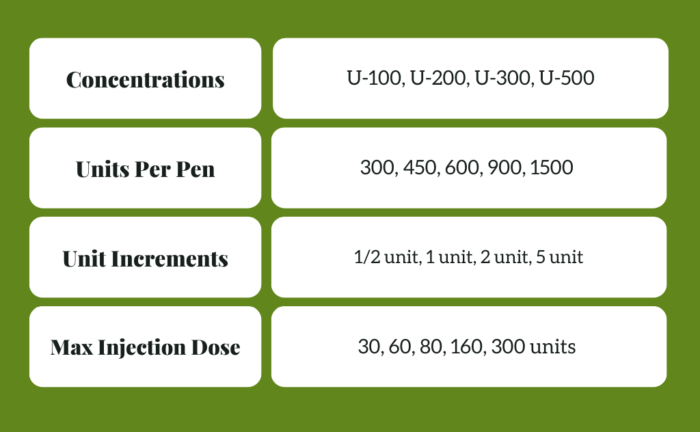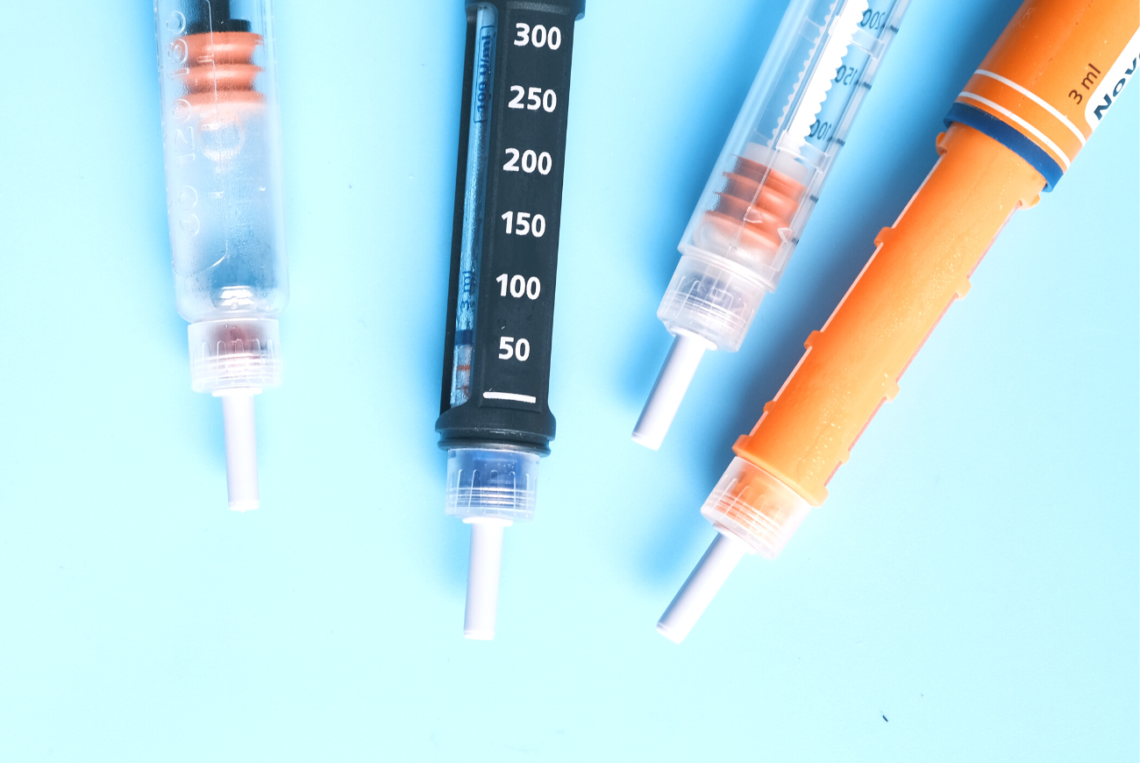
Your Guide to Diabetes Supplies: Insulin Pens
For many people living with diabetes, insulin injections are a part of everyday life. Traditionally prescribed using the vial and syringe method, insulin pens are becoming increasingly popular for their ease of use and comprehensive insurance coverage.
Insulin pens offer a convenient and discreet way to administer insulin while on-the-go. They are easy to use, provide accurate dosing, and reduce the risk of needlestick injuries. This article covers the functionality of insulin pens, instructions for use, and tips for troubleshooting common issues with your patients.
What is an Insulin Pen?
An insulin pen is a medical device used to inject insulin for the treatment of diabetes. It looks similar to a writing pen, but has a cartridge filled with insulin and a needle for injection. It simplifies the process of insulin administration, making it easier for patients to manage their diabetes.
Parts and Pieces of an Insulin Pen
Insulin pens consist of several parts and pieces that work together to deliver the desired dose of insulin. The main components of an insulin pen include the outer pen body, cap, cartridge, plunger, dosing window with knob, rubber seal, injection button, and needle.
- The outer pen body and cap are usually made from disposable plastic, though some smart pens are made from reusable metals.
- The cartridge contains the insulin and is secured with a rubber seal.
- The the injection button is used to push the plunger forward to propel the insulin out of the cartridge and through the needle.
- The dosing window and knob allows the user to select the desired dose of insulin to be delivered.
- The needle is the component that injects the insulin into the body.
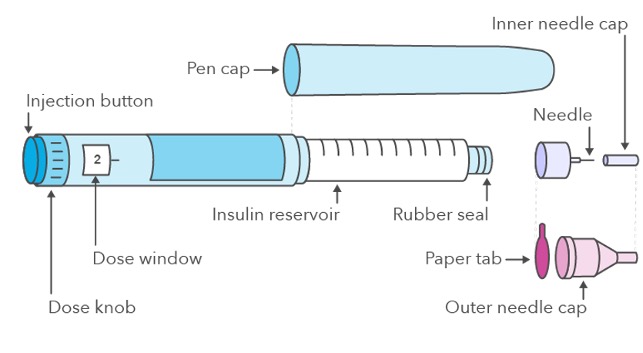
Insulin Pen Specifications
Insulin Concentrations
Insulin pens are available in different concentrations to meet the varying needs of individuals with diabetes.
- U-100: This is the standard concentration of insulin in most insulin pens. U-100 means that there are 100 units of insulin per milliliter (100 units/mL). It is the most widely available concentration and is used by the majority of people with diabetes who require insulin.
- U-200: U-200 insulin pens contain a higher concentration of insulin, with 200 units of insulin per milliliter (200 units/mL). U-200 pens are typically used by individuals who require larger doses of insulin, as they can deliver twice the amount of insulin with each unit compared to U-100 pens.
- U-300: U-300 insulin pens contains 300 units of insulin per milliliter (300 units/mL). U-300 insulin is even more concentrated than U-100 and U-200 insulin. U-300 insulin is used by people who require even higher insulin doses, particularly those with severe insulin resistance. This allows individuals to inject smaller volumes of insulin to deliver the same number of units, which reduces the number of pens needed.
- U-500: U-500 insulin contains 500 units of insulin per milliliter (500 units/mL). It is typically used for individuals who have severe insulin resistance and require very high doses of insulin. It’s unique pharmacokinetics mean that dosing frequency and indications differ from U-100, U-200, and U-300 insulins.
Units per Pen
The number of units in an insulin pen vary depending on the insulin concentration and model—certain “max” pens allow for a greater volume per pen without increasing the concentration. Most U-100 insulin pens have a total capacity of 300 units. As the concentration increase, so does the volume. U-500 pens contain 1500 units per pen.
Unit Dosing Increments
The unit dosing increment for insulin pens can vary depending on the specific pen model and brand. Most U-100 insulin pens dose in 1-unit increments, with some “junior” and smart pens offering half-unit dosing. As the insulin concentration increases, unit increments usually follows, including 2- and 5-unit increment dosing.
Max Injection Dose
The maximum injection dose refers to the maximum quantity of units someone could administer in one injection. It’s the highest number you can twist to on the dial. For U-100 insulin, the maximum injection dose ranges 60 to 80 units per injection. For higher concentrated insulins, the maximum injection dose ranges from 80 to 300 units per injection.
What is a Pen Needle?
A pen needle refers to a short, thin, and pointed hollow needle that attaches to an insulin pen to administer insulin. Pen needles come in different lengths, gauges and styles. Pen needles are designed to be used once, then disposed of in a sharps container.
Types of Pen Needles
The most basic style of pen needle features a short and thin needle attached to a plastic cap, available in a variety of lengths and gauges. Safety needles have an additional plastic canister to help prevent needlesstick injuries and reuse of needles.
Pen Needles Sizes— Gauge and Length
Size matters. Pen needle length and gauge can make all the difference in terms of comfort and good absorption. Needles range from 4 mm in length to 12.7 mm. Needle thickness, called gauge, ranges from 29G to 34G. A lower gauge is associated with a thicker needle.
Shorter needles are preferred. Most insulin-naive patients should use a 4 or 5 mm pen needle. Contrary to popular belief, body adiposity is not associated with needle length. Patients with greater body fat do not require longer needles.
Longer needles are best suited for high-volume injections or those with fibrous scare-tissue, where a deeper subcutaneous injection would help with absorption. Needle gauge increases with length—longer needles are usually thicker, allowing for improved flow and decreased injection force.
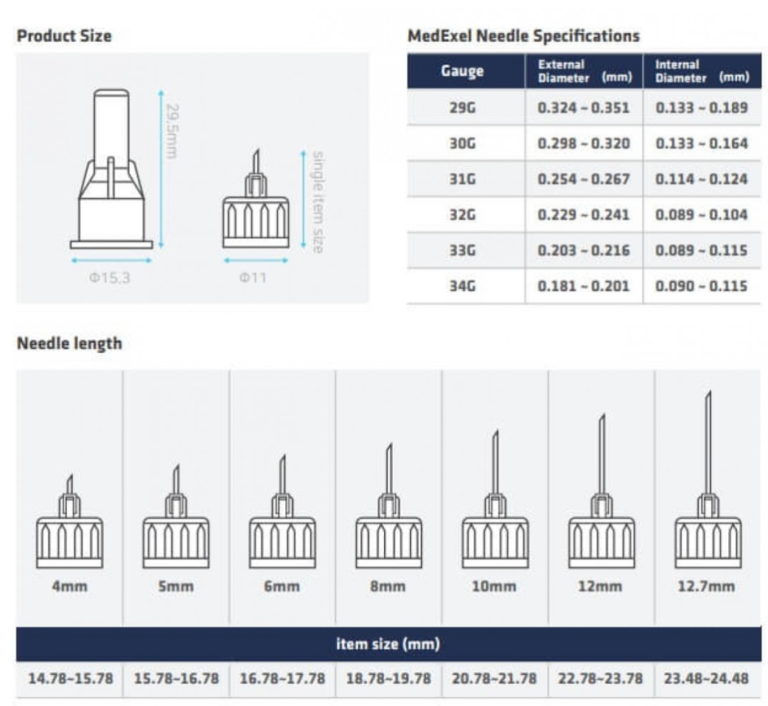
Using an Insulin Pen
Teaching a Patient How to Use an Insulin Pen
This instructional video provides a comprehensive step-by-step guide on how to properly use an insulin pen for administering insulin.
To Pinch or Not to Pinch?
Known as the skinfold technique, pinching the skin creates a “tent” of adipose tissue above the muscle to ensure the injection is administer into subcutaneous tissue. This can be helpful when using a pen needle greater than 6mm in length, but is not necessary with shorter needles.
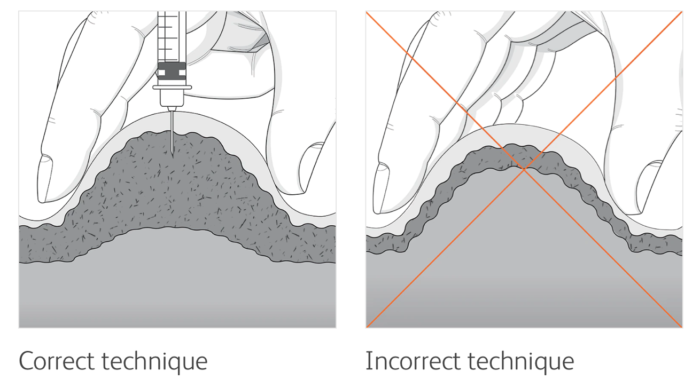
Common Issues with Insulin Pens
While insulin pens are generally reliable and convenient devices for insulin administration, there are some common issues that people may encounter.
Blocked or Bent Needles
Pen needles can become blocked or bent, making it difficult or impossible to deliver the insulin. This can occur due to needle reuse, improper needle handling, or issues with the pen itself. It’s important to use a new, sterile needle for each injection and properly store and handle the pen to prevent damage to the needle.
Incorrect Dose Selection
Users may sometimes select an incorrect dose on the pen, leading to over or underdosing. This can occur due to mistakes in reading the dosage markings or not aligning the dose selector properly. It’s crucial to double-check the selected dose on the pen and ensure it matches the prescribed dose.
Injection Site Issues
Injection site problems can arise from improper site selection, poor rotation, or using areas with lipohypertrophy (thickened fatty tissue). Injection site issues can affect insulin absorption, leading to inconsistent blood glucose control. Teaching proper injection site rotation is key!
Air Bubbles in the Pen
Air bubbles can sometimes form in the insulin pen, which can affect insulin delivery accuracy. It’s important to properly prime the pen to remove any air bubbles before each injection. See How to use an Insulin Pen video for instructions on priming.
Difficulty in Dose Delivery
Occasionally, individuals may encounter difficulties in delivering the full dose of insulin from the pen. This can happen due to mechanical issues with the pen, such as a malfunctioning plunger or cartridge. It’s best to have patients discard and open a new insulin pen.
Key Takeaways
- Insulin pens are convenient and user-friendly devices used for insulin administration.
- They provide a simple and discreet method for injecting insulin.
- They are available in a variety of concentrations and dosing increments depending on a patient’s needs.
Please reach out to me if your office or organization could use a hands-on refresher on insulin pens and other diabetes supplies!


You May Also Like
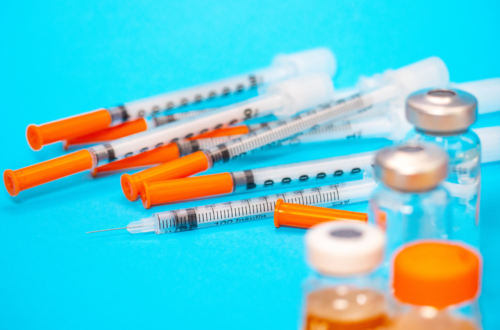
Your Guide to Diabetes Supplies: Insulin Syringes
August 1, 2023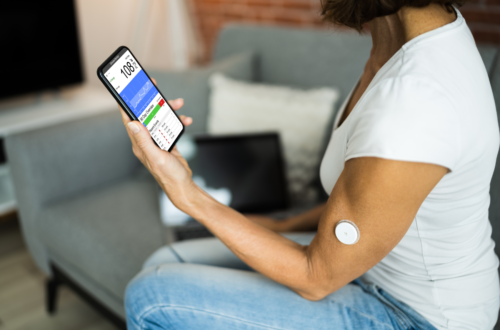
Your Guide to Diabetes Supplies: Continuous Glucose Monitoring
November 27, 2023

